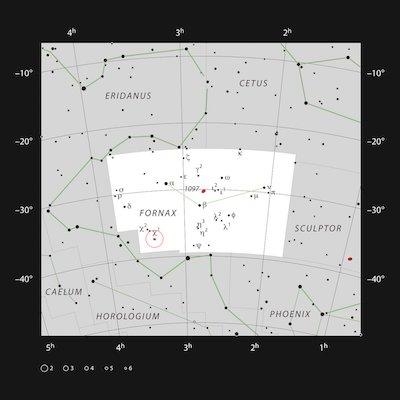European Southern Observatory Studies The Cluster In Detail
Countless galaxies vie for attention in this monster image of the Fornax Galaxy Cluster, some appearing only as pinpricks of light while others dominate the foreground. One of these is the lenticular galaxy NGC 1316. The turbulent past of this much-studied galaxy has left it with a delicate structure of loops, arcs and rings that astronomers have now imaged in greater detail than ever before with the VLT Survey Telescope. This astonishingly deep image also reveals a myriad of dim objects along with faint intracluster light.

Captured using the exceptional sky-surveying abilities of the VLT Survey Telescope (VST) at ESO’s Paranal Observatory in Chile, this deep view reveals the secrets of the luminous members of the Fornax Cluster, one of the richest and closest galaxy clusters to the Milky Way. This 2.3-gigapixel image is one of the largest images ever released by ESO.
Perhaps the most fascinating member of the cluster is NGC 1316, a galaxy that has experienced a dynamic history, being formed by the merger of multiple smaller galaxies. The gravitational distortions of the galaxy’s adventurous past have left their mark on its lenticular structure. Large ripples, loops and arcs embedded in the starry outer envelope were first observed in the 1970s, and they remain an active field of study for contemporary astronomers, who use the latest telescope technology to observe the finer details of NGC 1316’s unusual structure through a combination of imaging and modelling.
The mergers that formed NGC 1316 led to an influx of gas, which fuels an exotic astrophysical object at its centre: a supermassive black hole with a mass roughly 150 million times that of the Sun. As it accretes mass from its surroundings, this cosmic monster produces immensely powerful jets of high-energy particles , that in turn give rise to the characteristic lobes of emission seen at radio wavelengths, making NGC 1316 the fourth-brightest radio source in the sky.
NGC 1316 has also been host to four recorded type Ia supernovae, which are vitally important astrophysical events for astronomers. Since type Ia supernovae have a very clearly defined brightness, they can be used to measure the distance to the host galaxy; in this case, 60 million light-years. These “standard candles” are much sought-after by astronomers, as they are an excellent tool to reliably measure the distance to remote objects. In fact, they played a key role in the groundbreaking discovery that our Universe is expanding at an accelerating rate.

This image was taken by the VST at ESO’s Paranal Observatory as part of the Fornax Deep Survey, a project to provide a deep, multi-imaging survey of the Fornax Cluster. The team, led by Enrichetta Iodice (INAF – Osservatorio di Capodimonte, Naples, Italy), have previously observed this area with the VST and revealed a faint bridge of light between NGC 1399 and the smaller galaxy NGC 1387. The VST was specifically designed to conduct large-scale surveys of the sky. With its huge corrected field of view and specially designed 256-megapixel camera, OmegaCAM, the VST can produce deep images of large areas of sky quickly, leaving the much larger telescopes — like ESO’s Very Large Telescope (VLT) — to explore the details of individual objects.
(Images provided with European Southern Observatory news release)
 Aero-TV: DeltaHawks Diesel Power Steps Into the Spotlight
Aero-TV: DeltaHawks Diesel Power Steps Into the Spotlight NTSB Prelim: Mooney Aircraft Corp. M20K
NTSB Prelim: Mooney Aircraft Corp. M20K ANN FAQ: Turn On Post Notifications
ANN FAQ: Turn On Post Notifications ANN's Daily Aero-Linx (12.20.25)
ANN's Daily Aero-Linx (12.20.25) Aero-News: Quote of the Day (12.20.25)
Aero-News: Quote of the Day (12.20.25)




